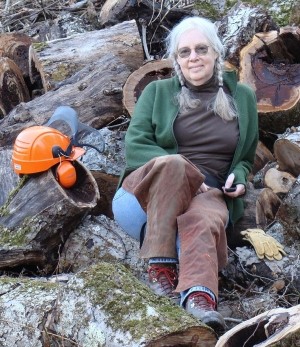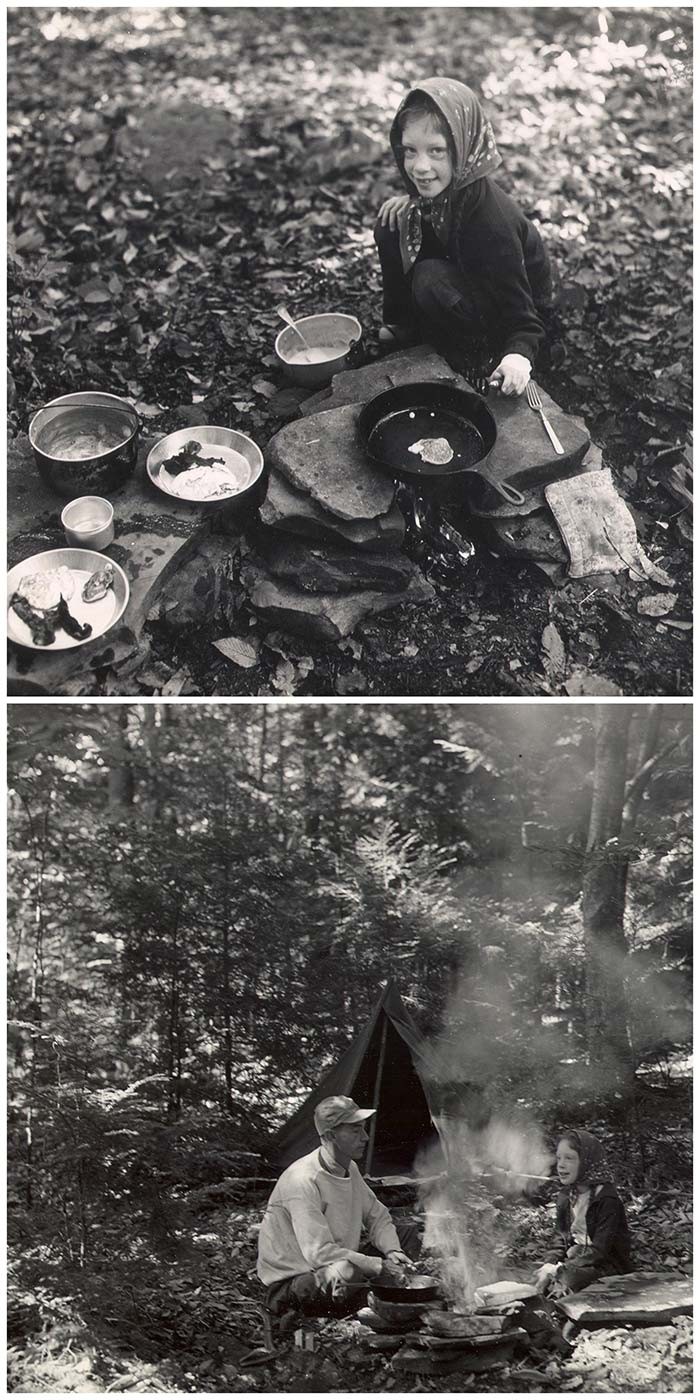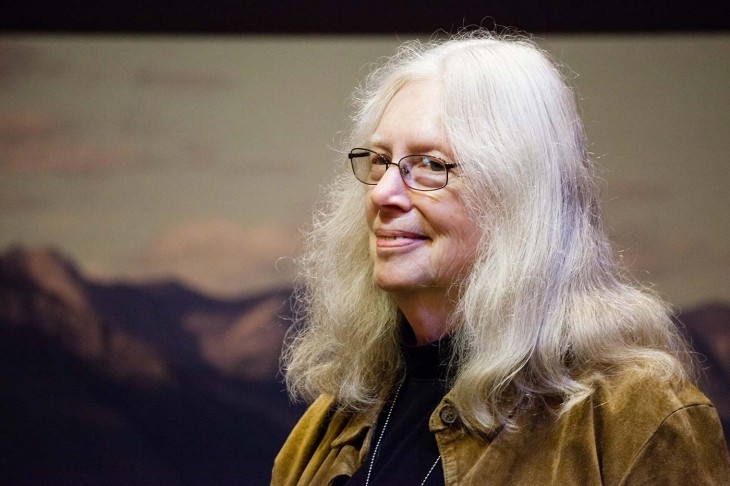
For Nancy Baker, tending to the region’s woodlands is “all about caring well for the forest.” She manages land that has been in her family since 1861, and over the years has earned myriad honors for her stewardship efforts. She has been named a Chesapeake Forest Champion, an Exemplary Forest Steward, and in 2009 was presented Pennsylvania’s Joseph Trimble Rothrock Award for Forest Conservation. She is on the board of the Pennsylvania Forestry Association, a member of the council for James C. Finley Center for Private Forests at Penn State, and sits on the steering committee for the Pennsylvania Forest Stewards. She’s also involved in Pennsylvania’s Women and Their Woods, a program she helped start in 2008.
My parents are both from Pennsylvania, one from the northern tier and one from the southern tier, but they both moved out of these rural areas because the salaries weren’t high enough. I grew up 17 miles outside of Manhattan. In the public schools I attended, my teachers all had degrees from Ivy League colleges. My German teacher had a doctorate from the University of Vienna. Manhattan had incredible museums and music and art and botanical gardens and just magnificent educational possibilities, and we took advantage of them. I grew up in such a diverse neighborhood – across the street were Ukrainians, and to my right were a family from Hungary, to my left was a Dutch couple. I was raised by this amazing, diverse village.
But I lived for going to the country. I spent all my summers, all my weekends, school holidays at my grandparents’ farm in the northern tier of Pennsylvania. I just loved being in the country. That’s where I am now. I’m sitting in the house that my grandfather built. I grew up without television. I’m an only child. All that combined means you make your own fun. My father would say, “If you’re bored, it’s your own fault.” When I was in Pennsylvania, I was outside. I could go anywhere. There’s a stream in the front yard, and I could go down into the stream and play with the rocks. I could sit under the maple trees, up close and personal with tiny fern forests, or under oak trees making cups and saucers with acorns. I just played with whatever I had.
My dad loved to hunt and was also a fly fisherman. He taught me how to fish and taught me how to use a rifle. He would bring in the rabbits and squirrels and grouse to the back porch, and he taught be how to clean the animals he caught. I have a lovely memory of my dad every time I pick up an axe. He taught me to use it ambidextrously, and to be proud of the skill – walking around the tree was unproductive in his book.
Since both my parents were educators, we had free summers, and we traveled. Wherever we were going, my dad would give me a map, and every once in a while, he would say, “Where are we?” I would have my finger on where we were and where we were going on the map. And we would play little games. We’d be driving down a wooded highway, and he would point to a tree and say, “What’s that?” My response was supposed to be, “That’s a sugar maple” or, “That’s a white oak.” If I missed, he’d say “Look at the twiggery!” It’s all about observation and taking the time to look.
Scientists and artists are very similar in that they both have to be very close observers. I keep a nature journal, one that the Center for Private Forests at Penn State provides to each attendee at statewide conferences. I like that it is hitched to a numerical calendar, rather than days of the week, and can be used repeatedly for a number of years – perfect for keeping track of phenology. I have my dad’s calendars from the 1950s and 1960s and can go back and compare items. I find myself sketching reasonably often; a habit left over from biology labs.
I have a bachelor of arts degree in biology with a minor in English and a minor in anthropology from Bucknell University. What do you do with that? You go to grad school. So, I went to the University of Georgia for a master’s degree. The Institute of Ecology was led by Eugene Odum, who was renowned for his pioneering work on ecosystem ecology. I just had a ball. I really loved it. The Institute of Ecology embraced everyone. It was not just the science of ecology. It embraced law, landscape painting, music, poetry. It was just tremendously full of ideas at that point. I’m a person who likes the flexibility of big ideas happening.
When I was in grad school, one of my professors asked me if I would like to go to the national fire ecology conference, so I did. There were 161 guys and me. It was held outside of Tallahassee, Florida. I drove down there and I walked in to register, and the two secretaries looked at me and said, “Just give us a minute here.” There was no other woman there, and they had to rearrange the rooming system. When you’re the only woman in the room, you have to stand on your own feet. You have a responsibility to know what you’re doing, stand on your own feet, and don’t take any guff. Out of self-preservation, I learned how to chew tobacco. I could spit accurately enough to hit their shoes, and then they would leave me alone. That says a little bit about the culture of women in forestry at that time. But they were great guys, and I had a good time.
This land has always been important to me. It’s been in my family since 1861. There are two streams that come together in my land. One is Crane Creek and the other is the Panther Lick. We call this property the Panther Lick. In Appalachian terms, “lick” is sometimes used as a word for a stream or a creek. There used to be panthers here, but not anymore.
My great-grandfather was a logger and a sawmill owner. This land was held in a complicated estate before the Civil War and was not logged until my great-grandfather bought it. This was probably the last original timber that was taken off in this area. Part of it was eventually farmed. Part of it was allowed to regrow. I do have some acreage that is second growth from the 1860s. My dad bought adjoining farms, mainly pasturelands, in the late 1940s and increased the acreage. He went to the local conservation district and the Bureau of Forestry and asked what he should do with the pastureland, and they said, “Plant it to trees.” So I have 60,000 red pine, and I have white pine and Austrian pine that are pine plantations.
The property is a mosaic. It’s 163 acres, primarily reverted farmland. It was the kind of farm that had seven cows and four horses and a pair of oxen, chickens and geese, and sheep under the barn – just the whole gamut of a subsistence farm. I keep the fields open, although I’ve increased the width of the hedgerows. I know the work that my family put into clearing those fields. They started from forested land and went to pulling stumps and built beautiful stone walls. That’s a lot of work, and I have to honor that work.
Being a forest ecologist, I’m not really keen on forest plantations. After my mom died, I went to the Bureau of Forestry and consulting foresters and asked how do we convert these pine plantations to hardwood? When I inherited this land, my husband and I walked the entire boundary on a very cold and clear New Year’s Day, a day of incredible delight – and the realization of the weight of major responsibility of stewardship and tending.
My initial goal was to foster the integrity of a hemlock/northern hardwoods ecosystem. At one point, I was standing out in the middle of a stand of red pine with five foresters – the Penn State Extension Forester, the Penn State Regional Extension Forester, the Center for Private Forests Forest Stewardship Associate, the Bureau of Forestry Service Forester, and my consulting forester. They were having a rather heated argument about how to convert the stand from pine plantation to hardwood stand. Eventually, there was a consensus to create a control plot plus two treatment plots: one a thinning and the second a thinning plus herbicide to control invasives, both treatments to promote increased light on the forest floor. Cut timber to remain on the ground as a deterrent to deer. Retain select hardwoods of multiple species as seed source.
I work with a consulting forester, and our ideas are parallel. We’re both adherents of big picture, long term, adaptive management. The original management plan has been tweaked every year for nearly 25 years. We take at least one full day a year to plan out ahead, and we communicate every week or so about what’s going on in the woods and the world – we’re good friends.
Today’s the regenerative growth is above head high; we would probably cut other plots in the future harder, but the more light, the more invasives you need to control – a constant battle in Pennsylvania. The mid-Atlantic is really getting walloped with invasive species and diseases. I have more than 70 years of looking at this particular plot of land and watching it through those years of warming temperatures, hemlock woolly adelgid, emerald ash borer. I have white ash that are almost 30 inches in diameter, prime ash, in the land that regrew after the 1860s. I have got to the point of treating 10 of them just to save the seed source. But many of those huge ash are coming down in the woods. We’ve lost chestnut in Pennsylvania. We’ve essentially lost beech. We’ve lost hemlock. Maple are not doing great. It can be very depressing and kind of discouraging.
Somehow, I’m incapable of giving up. I think I see a change in attitude from many forest landowners. In the ’60s, ’70s, maybe the ’80s, most forest management was timber oriented and financially oriented. If you survey forest landowners in Pennsylvania now, timber is number 10 on their list of goals. Solitude is number one. Wildlife, I think, is number four. That means that management is not quite so financially driven. The forest industry has an extremely important role to play in the way our forests and society move through time, and harvesting timber will always be an important part of that; we all need to care for the resource. In Pennsylvania, we’re starting to think about training our foresters differently as they come through school. The job is changing from marking a timber sale to caring well for the woods. That takes a whole different skill set. It takes a different set of business and communication skills. It takes listening to landowners and finding a way to meet the landowner’s goal, even if it’s not a financial goal. It’s all about caring well for the forest, so that gives me some hope.
In 2000 I completed the four-day Pennsylvania Forest Stewards training. All of the women participants stayed in one dormitory. None of us knew each other, and nobody was talking with anybody. So I asked them to share how they felt about their woods. Then I asked how many of them worked in their woods, and there were just about zero. Most of them were married, and their husbands worked in the woods, and their husbands made the decisions. And that got me thinking, and it got those other women thinking, too.
Statistically, women live longer than men, and they wind up with land and no management experience. I started getting calls from women asking for advice, and in 2008 we started having four meetings a year for just women landowners. Everybody would bring a dish to pass. We’d learn something. Just simple management and how to think about this. Then we took the Pennsylvania Forest Stewards four-day peer-training model and started offering that for women only; it was very different. It was phenomenal. It just built a real dynamic community. Now there’s a Women Owning Woodlands national website, which is an offspring of this movement to educate women. To build a community of women who can rely on each other – it’s been very successful.
I’m also involved in an informal partnership called Walk in Penn’s Woods. The goal is to have one Sunday each year where we try to get people into the woods with a resource professional. I define walk in a really broad way. If you’re going down the river in a canoe, looking at the woods with a resource professional, that’s a Walk in Penn’s Woods. If you’re driving 30 miles through state game lands with a wildlife biologist, that, to me, is a Walk in Penn’s Woods – even better, because it’s a handicap accessible walk. Some years we have over 1,000 people in the woods and almost 90 walks. People love them, and all the questions get answered. Forestry in many states is constrained by laws, and law depends upon the citizens. Unless you have an informed citizenry, you’re not going to make any progress.
I’m so appreciative of all those who have humored me and worked with me on this long adventure in forestry. So many helped me step out of being an introvert, steadied me on a wonderful journey through listening, courageous vulnerability, and servant leadership – and made many of my wild ideas come true.





